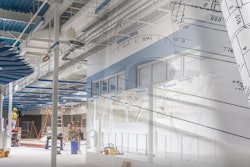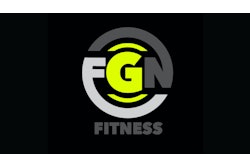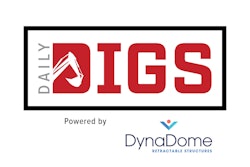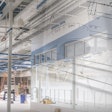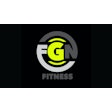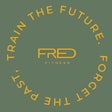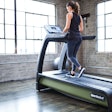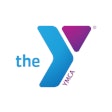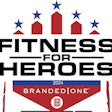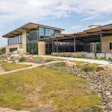In new constructions and remodels, decide if spending more now will reap you rewards later.
No longer the warehouse-like buildings of the past, modern fitness centers have character and ambience, as well as utility. In a new build or a remodel, how do you give your facility long-term endurance? In short, how do you begin with a box and end with "bling"?
Industry veteran Tom Durkin, owner of Fitness World West in West Des Moines, Iowa, and Ames Racquet & Fitness Center (with three locations) in Ames, Iowa, and who has designed or redesigned more than 20 fitness sites, says that learning from his mistakes can be the secret to getting it right. Ask anyone who's built a new fitness facility what they would have done differently, he suggests, and you'll learn quickly how to get your fitness center closer to a perfect fit the first time.
Planning stages
Establish your need. What do you need in your new space? What is your core business? Who do you serve? The answers to these questions should include the job-specific duties of greeting members, selling memberships and personal training, offering training, group fitness and other profit centers, appealing to the age demographics of your customers and meeting the storage needs of your business.Establish your location. If you're creating a new building, location is everything. Consider the traffic patterns, accessibility and visibility. Consider how many rooftops you can see, meaning the number of houses or businesses and people in them who will find your business convenient. Look for surrounding "gathering places" such as churches, malls, schools and grocery stores. Think about the future growth of the area. You want to see your location tomorrow and five years into the future, and avoid becoming yesterday's news because growth of the community goes in another direction.
According to Durkin, the price of the land alone does not determine the best option. Paying $2 to $5 more per square foot for ground at the right location will make up for itself in the long run. Building on the wrong spot because of the right price is rarely the right answer.
Also consider whether there is room for expansion on the site. It's wiser to build too small and need to expand than to build too big and not be able to pay the bills.
Plan where the building will sit on the lot, and where the front doors need to be for best accessibility and use of parking space. When the sun is rising and setting, what effect will it have on the light in the rooms? Will the building be in the sun or shade? These questions are best answered now.
Concept phase
Get the culture you want to create, the message you want to send and the vision for your business on paper. If customers walk in and see your passion for fitness, and feel the way you want them to feel about it, you've been successful. Put your mission statement into the reality of what you will offer and how you will present it.In the concept phase, you are basically creating a wish list. Include everything you want on paper. For Durkin and his 2005 22,000-square-foot Ames Racquet & Fitness Center build, that meant cherry wood lockers, Italian tile, hardwood floors, 12-foot-wide hallways, flat screen TVs in the lobby and locker rooms, exterior walls of mostly windows and high ceilings.
|
||||||||||||||||||||
Box
Take the services you offer and allocate space for them. Place the rooms in boxes within your big box. Start looking at your flow from room to room. Determine your return on investment (ROI) in each. Your offices for staff to sell memberships and services should be functional, not extravagant. Money isn't made in the office; it's made on the fitness floor. Be careful not to invest too deeply in something that won't get you a return.The front desk is one of the most important hubs in the building, and it should be an area you spend time thoroughly planning. You will need to accommodate a number of people at peak times, so make sure it is not too small. And, you will need to ensure that the desk is neither too big or deep to allow for personal service and contact.
Avoid marking one room for one purpose. To get the most ROI, make sure rooms will get maximum use the majority of your open hours. Also, leave yourself options for future use. A retractable soundproof wall may initially add 25 percent to the cost of a wall separating two rooms, but, in the future, it will provide well-worth-it options for your space. Having the option to change the lighting is something else to consider. Will you want to change the lighting for an event, for a different class or type of energy you want to create? Dimmer switches in smaller spaces are an option. In larger areas, a solution is a dual switch that costs $10 to $20 more per switch, yet can be wired for your needs using just two inside or outside bulbs, for instance, rather than all four all the time. Hosting the grand opening or Christmas gala? Change the mood with a flick of the switch.
When it comes to size, the free weight area will likely be used for personal training, so there is a need for floor space, wall space and mats for stretching - in addition to accommodating the weights. The group fitness studio will also serve as a storage space for small equipment; plan for that in this area.
Temperature controls in each room are a good investment. A multipurpose room used for mind/body exercise needs to be warmer than a cardio group fitness space. Each of those needs vary from the temperature at which the facility's larger spaces are kept.
The building's footprint is always the most expensive part of space; building up or down costs less. Storage space built under your business is more convenient and more cost-effective than other options over time. A second floor, whether in the budget now or not, should be something you plan for in the original building phase.
Once the schematic drawings are made, get feedback, criticism and input from your partners and employees, and don't ignore your gut. Go back to the drawing board and repeat the cycle until your architect comes up with a drawing you're happy with. Then get the price on building your dream facility, and return to reality. Finally, go back to the architect with revisions you can afford.
Bling
When the reality of the cost of your dreams sets in, you have to make the difficult choices. The space, lighting and materials you use all make a difference in the atmosphere you create. It takes thought - down to the detail - about whether marble or granite counters will show more water stains.Durkin went with the best of the best in his 2005 build, wanting to get it right. The hardwood floor in the group fitness studio cost $38,000 for 1,600 square feet. In a later remodel at another location, he added a 2,000-square-foot studio with a $9,500 investment in an imitation wood floor. He reports that both members and staff positively comment on the cheaper version. Again, price isn't always the best indication of value, so look at all angles.
If space is money, a 12-foot-wide hallway makes no sense. It has made cents, however. Of the three Ames Racquet & Fitness Center locations Durkin has, there is more revenue generated from the 2005 building due to the ambience created there. "I have no proof, but, of the three locations we have in the same community offering the same services, there is more revenue generated at this site per square foot than at the other two," Durkin says. Having it to do over, he would go with a 10-foot-wide hallway, and give the additional space to the nursery/kids gym area. "I'd get the same effect and have a more functional use of the square footage," he says.
Natural sunlight fades everything from chairs in the pool area to leather seats in the lobby and posters on the wall, and heat and air conditioning bills can be more with glass walls. Even so, the effect of having windows provide natural light and free advertising at night when people drive by offsets the cost. And, says Durkin, it turns out to be one of the things people like most about the facility. It's light, bright and open, aided by high ceilings - another higher-cost investment.
Don't be afraid to spend money in the locker rooms, says Durkin. Many owners who build cut corners there. However, beautiful locker rooms create satisfied customers, and those customers create referral business. When Durkin had members saying that the locker rooms were nicer than their bathroom at home, he knew he'd done the right thing.
A set of sliding glass doors provides the entrance to Durkin's "bling" facility, born of seeing a young mother with three children struggle through the doorway of another facility. It has served older members and post-rehab clients equally well. During inclement weather, the alcove between the set of doors provides a sheltered area for customers to open or close their umbrellas or stomp off snow. Is it the cheapest option? No. Would he do it again? Absolutely.
Functional with a statement
When planning your facility, don't listen to the architect without thinking first yourself. Unless your architect specializes in fitness design, he/she doesn't know this business like you do. It isn't like most other buildings designed for business, Durkin says. What other businesses do people frequent three or more times per week, spend one or more hours there at a time, and shower and use the locker room as if it were their personal space?You are building a place for people to enhance their lives. If you add details and they walk out having not noticed, in Durkin's opinion, you failed. You are making a statement with your building. You can't build all for fluff, but fluff with function can be effective in many ways, from box to bling to cha-ching.


















